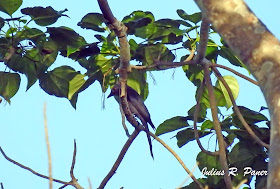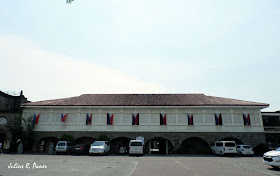I
was welcomed by set of lifers in Puerto Princesa when I attempted a hurried
birding in a compressed schedule of ASEAN Heritage Park forum last June 18-20. The
ultimate goal was to just see the critically-endangered Philippine Cockatoo
which I initially knew of as having good stay in Puerto Princesa.
My
first choice was to go to Rasa Island but I learned it was very far from my
venue. With an idea given by fellow birder Ivan Sarenas I could have settled
for an option trip in the municipality of Narra, another known site of
Philippine Cuckatoos. Instant phone talk with the Tourism Office staff of Narra
gave me further information that there are already sightings of the bird in
Puerto Princesa. Lastly, with a noble assistance from Miss Indira of Katala
Foundation, Inc. I was able to confirm that Katala (local name of Philippine
Cockatoo) is indeed just around the corners of Puerto Princesa and finding them
would be a tall order for me to undertake.
I
headed to the point unknown to me in the very early morning of June 19 and in a
coastal site eastbound I saw flock of Katala perching in a single coconut tree.
The total count was 20 pieces. Unlike other endangered species the Katalas are
not really afraid of human, that maybe the reason they are very much prone to
poaching. I stayed quite a distance from them and noticed they changed location
rarely. After about 15 minutes they transferred to a mangrove area along the
shore but returned later in the coconut tree. Puerto Princesa is a favoured
refuge of these birds and the initiative and efforts exerted by Katala
Foundation in conservation and protection of threatened wildlife merits some
mega applause.
 |
| Katalas perching in dried tree brances |
 |
| Katalas perching in Mangroves |
 |
| Flock of Katalas flying against the Sunrise of Puerto Princesa |
Out
of interest I continued birding south bound from the location of the Katalas
and the very first bird I saw were couple of OIive-backed Sunbird with a
different appearance, an Aurora sub-species with the male having orange blush
on the chest. An immature specie then also joined this couple group afterwards
which I mistakenly identified as Lovely Sunbird but Ivan told me the latter
could only be seen in forested areas.
 |
| Olive-backed Sunbird Aurora Race (Male) |
 |
| Olive-backed Sunbird Aurora Race (Immature Female) |
 |
| Olive-backed Sunbird Aurora Race (Female) |
Another
lifer is Rufuos-tailed Tailorbord, hopping from one tree branch to another with
two immatures spotted in opposite direction and down further. It is actually
common in Puerto Princesa but still a great find. Eight calls of Hooded Pitta
were heard all throughout the place but no single bird showed up,
understandably because this bird is really shy and hard to spot. Common Iora
was also spotted in the place with its tempting plumage.
 |
| Rufuos-tailed Tailorbird |
 |
| Rufuos-tailed Tailorbird |
 |
| Rufuos-tailed Tailorbird |
 |
| Common Iora |
The
Ashy-fronted Bulbul came as a surprise addition, perched in very quickly and
after my two clicks it flew through canopy of grasses. Big brother Pete Simpson
told me this bird used to be called Olive-winged Bulbul but was split and now
another part of the Palawan endemic lists. Pin-stripped Babbler, Black-headed
Bulbul, Ashy Drongo, White-vented Shama and Slender-billed Crow round off my
excellent lifer record in Puerto Princesa.
 |
| Ashy-fronted Bulbul |
 |
| Pin-striped Babbler |
 |
| Ashy Drongo |
 |
| Black-headed Bulbul |
 |
| White-vented Shama |
As
a secluded island dubbed as Philippines’ Last Frontier, it is no surprise that
there is a higher degree of bird and other wildlife endemism in Palawan. In my
early days of birding this is perhaps one of the best birding sites in the
country other than Mindanao that I tagged as a must-visit for birding
enthusiasts. Suggested sites in Puerto Princesa for birding are the green
reserves in its coastal area and the backyard of the more popular Palawan
Wildlife and Rescue Center, a 30-minute ride from Puerto Princesa proper.
 |
| Rufuos Night Heron |
 |
| Spotted Dove |
1. Philippine Cockatoo
2. Olive-backed Sunbird Aurora Sub-species
3. Rufuos-tailed Tailorbord
4. Common Iora
5. Ashy-fronted Bulbul
6. Pin-striped Babbler
7. Ashy Drongo
8. Black-headed Bulbul
9. White-vented Shama
10. Slender-billed Crow
11. Pygmy Flowerpecker
12. Common Emerald Dove
13. Spotted Dove
14. Zebra Dove
15. Philippine Pied Fantail
16. Great Egret
17. Little Egret
18. White-breasted Woodswallow
19. Hooded Pitta
20. Rufuos Night Heron
21. Asian Glossy Starling
22. Collared Kingfisher
23. Eurasian Tree Sparrow
I have been gratified for this opportunity to be back to Puerto Princesa once again and at least I have been able to do birding. Thank you so much to the assistance extended by Ivan Sarenas, Miss Indira of Katala Foundation, Tourism Office of Narra and Big Brother Pete for always helping me do bird identification. Thank you also to Mt. Apo Protected Area Superintendent Sir Ed Ragaza, Froky and Sir Pablito Ofrecia for considering me to represent the Local Government to the ASEAN Heritage Meeting.







































